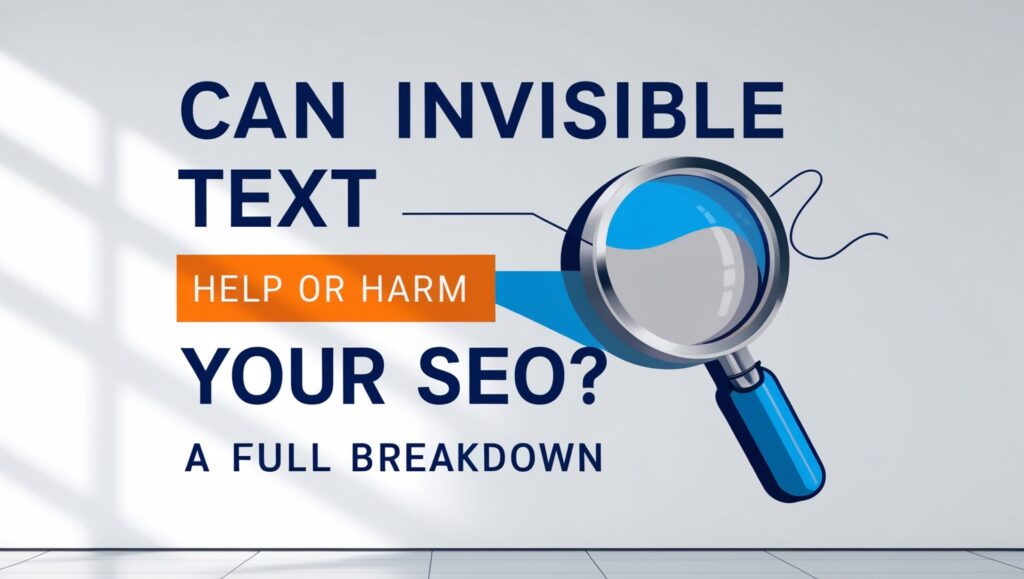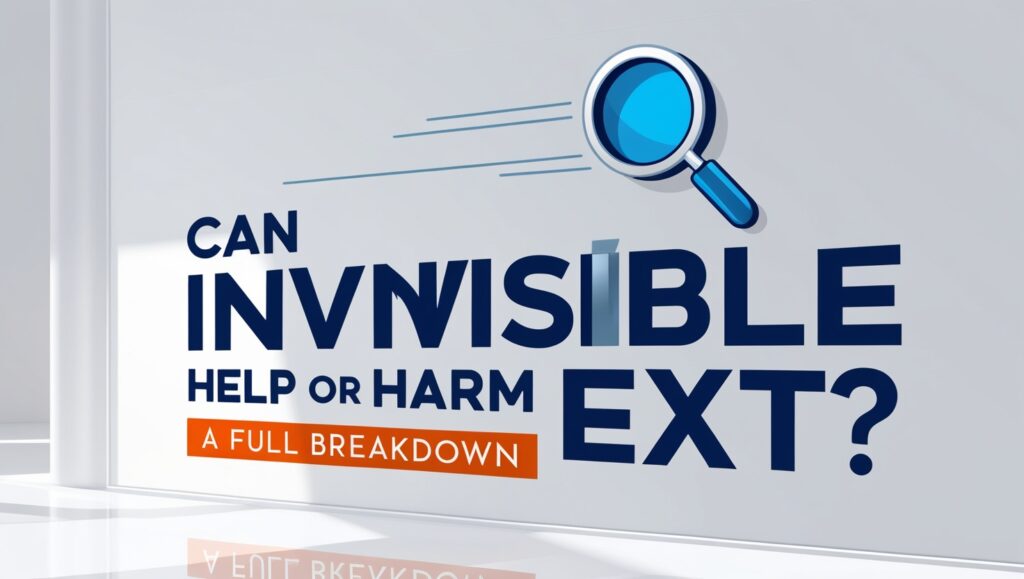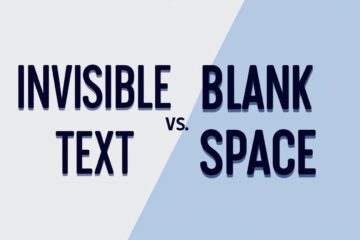What Is Invisible Text and Why Do Websites Use It?
Invisible text means words on a website that visitors can’t see, but search engines can still read. This might sound strange, but it happens more often than people think. As someone who has managed websites for over 10 years, I’ve seen this used both in smart, helpful ways — and in risky, harmful ways that led to big problems. I’ll break it all down in a way that’s easy to understand.
Sometimes invisible text helps users, like screen readers for blind visitors. But sometimes, it’s used to trick Google by hiding keywords. If you’re a site owner or blogger trying to improve your traffic, it’s important to know the difference.
What Are the Main Types of Invisible Text?
There are several common ways websites hide text. Some of them are used for good reasons. Others are used to cheat the system.
Common Methods of Hiding Text
| Method | What It Does | Code Example |
| Display: none | Hides text from users | <p style=”display:none;”>hidden</p> |
| Same color as background | Makes text invisible | White text on white background |
| Text off screen | Moves text far left/right | position: absolute; left: -9999px; |
| Font size zero | Makes text too small to see | font-size: 0 |
When I managed an e-commerce site, we found hidden text in our footer saying “cheap wedding dresses” over 100 times. A past developer thought it would help SEO. Instead, we got a warning in Google Search Console and lost rankings.
Is Invisible Text Good for SEO or Bad?

This depends on why you’re using it. If it’s for helping users, it’s okay. But if it’s for tricking search engines, you can get penalized. Search engines like Google clearly say that hidden text used to deceive is against their spam policies.
For example, if a website hides words like “buy cheap bourbon online” just to get attention, it’s spam. Google’s bots are smart and will catch this trick quickly.
Secondary Keyword: “SEO Penalty for Hidden Text”
Adding hidden keywords might seem like a shortcut, but it’s a fast track to an SEO penalty for hidden text. I’ve helped clients recover from these penalties. In one case, a company used tiny font size to stuff in 500 extra words. Their traffic dropped 80% in two weeks. We had to remove the hidden content and submit a request to Google to fix it.
To understand how penalties work, visit Google’s spam documentation.
When Is Invisible Text Okay to Use?
Invisible text is fine if it improves the experience for your users — especially users with disabilities. For example:
- A button with an icon might include hidden text that says what the button does
- An image might have a long description that is hidden from sight but readable by screen readers
These uses follow W3C accessibility guidelines and are considered good practice. I always recommend that my clients include this kind of invisible help. It improves your site and avoids legal issues too.
How Much Does Bourbon Cost? And Why Is It Used in SEO Examples?
Let’s talk about bourbon — a drink often used in fake hidden text tricks. People hide phrases like “best bourbon under $20” just to target common searches. But if that content isn’t really on your site, you’re asking for trouble.
Here’s a real example: One site I audited had invisible text that said “cheap bourbon, buy bourbon near me, best whiskey for gifts,” and none of it matched their product list. They lost their rankings fast.
Bourbon Price Table
| Brand | Type | Average Price |
| Evan Williams | Standard | $13–$15 |
| Jim Beam | Kentucky Bourbon | $17–$20 |
| Wild Turkey 101 | High Proof | $22–$28 |
| Maker’s Mark | Premium | $30–$38 |
| Pappy Van Winkle | Rare Bourbon | $500+ |
You can check prices and shop from sites like Drizly or Total Wine for real offers, not fake SEO bait.
Secondary Keyword: “Invisible Keywords in Web Design”
Web designers sometimes sneak in invisible keywords in web design. They do this to please clients who want “more traffic.” But this approach can backfire. I’ve worked with startups who had no idea their site was hiding text until they started losing rankings. Now I always audit new client websites carefully.
How to Check If a Site Has Hidden Text
There are simple ways to check if your site (or someone else’s) is using hidden text:
Step-by-Step
- Right-click the webpage and choose “Inspect”
- Look for styles like display:none, font-size:0, or text the same color as the background
- Search the source code for repeated keywords that don’t appear on the page
For deeper checks, I use tools like Screaming Frog or Ahrefs. These can scan your entire website and highlight hidden or spammy content.
When I worked with a news site that suddenly dropped in Google News results, we found that their guest writer had added hidden links to casino sites. After removing those and filing a report through Google’s spam report tool, the site was slowly restored.
What Happens When Google Finds Hidden Text?
When Google’s crawlers detect hidden text, they don’t ignore it — they investigate. If the text looks like it’s trying to manipulate rankings, your site may get a manual action or algorithmic penalty. That means your website can lose traffic, rankings, and even disappear from search results completely.
One of my clients, a fashion blog, used hidden links to affiliate products in white-on-white text. It worked for two weeks — then the blog’s traffic dropped by 60%. We had to remove all the hidden elements and request a manual review from Google Search Central. It took two months to fully recover.
So the risk is real. Even if it seems like a small trick, it can lead to a big problem.
Smarter Ways to Rank Higher in Google Without Hidden Text
Secondary Keyword: “SEO Best Practices for 2025”
Instead of trying to fool search engines, focus on SEO best practices for 2025 that actually work and are approved by Google:
Use Real, Helpful Content
Answer real questions from your audience. For example, if you’re a liquor store owner, write blog posts like:
- “Best Bourbons for Beginners in 2025”
- “Is Bourbon or Whiskey Better for Cocktails?”
- “Top 3 Bourbons You Can Buy for Under $25”
These are helpful, honest, and keyword-rich — without being spammy.
If you’re unsure what your audience wants, tools like Answer the Public and Google Trends can show you real questions people ask online.
Write Descriptive Alt Text and Titles
Instead of stuffing hidden keywords, use alt text for images and proper title tags. This helps with accessibility and SEO. If you upload a bourbon bottle image, don’t just name it “image1.jpg.” Use something like “Evan Williams Black Bourbon 750ml.”
The WebAIM alt text guide is a great source to learn how to do this correctly.
Build Trust With Google Over Time
Search engines reward websites that show expertise, authoritativeness, and trust — also called Google’s E-E-A-T principle. That means:
- Publish regular content
- Get backlinks from trusted sites
- Be transparent about your company
- Make your website fast and mobile-friendly
All these steps improve your SEO in the long run — no hidden tricks needed.
How Invisible Text Affects User Trust
Hidden text isn’t just a search engine issue. It can also make users suspicious. If someone visits your site and sees strange gaps or unclickable areas (because text is hiding behind images or layouts), they might leave — or worse, report your site.
One time, a reader emailed us asking why our “bourbon guide” page was showing broken text on their phone. Turned out the page had leftover invisible span tags from an old plugin. It looked fine on desktop but was a mess on mobile. We cleaned it up and learned that mobile experience matters more than ever.
If users lose trust, they won’t buy, subscribe, or come back. That’s why honest design matters just as much as good content.
Hidden Text and Legal Issues
Besides SEO penalties, hidden text could get you in legal trouble — especially if it’s used to deceive users. This is a big deal for businesses in finance, healthcare, alcohol, and other regulated industries.
For example, promoting bourbon to underage users — even with hidden links or text — can lead to big fines. Government agencies like the Federal Trade Commission (FTC) take deceptive online marketing very seriously.
I always advise clients to keep their content honest and transparent, not just for SEO, but for legal safety.
Real-World Example: A Site That Did It Right

I once worked with a small liquor brand that wanted to rank higher for “craft bourbon under $40.” Instead of hiding text, we added a simple product guide with:
- Bourbon comparisons
- User reviews
- An FAQ section with real questions from Google’s “People Also Ask” box
- Internal links to product pages
We also got them listed on Distiller, a respected bourbon review site. Within 3 months, their organic traffic doubled — with zero tricks, zero hidden code.
That’s the kind of SEO strategy I recommend to every client now.
Final Thoughts: Invisible Text Can Harm More Than It Helps
Using invisible text to cheat search engines might give you short-term traffic, but it comes with long-term risks — penalties, lost trust, legal trouble, and user confusion.
Instead, use clear and honest content. Write guides, product reviews, and helpful blog posts. Use alt text and meta tags the right way. Test your site for hidden code with tools like SEMrush, Screaming Frog, and browser inspect tools.
As a professional manager who’s fixed dozens of websites affected by hidden text, I can tell you this: clean SEO always wins in the long run.
If you want to learn more about doing SEO the right way, check out these trusted resources:
- Google Search Essentials
- Moz SEO Learning Center
- Search Engine Journal – Technical SEO



